In an HCEUSA article in 2020,1 Becket Gremmels proposed staffing criteria for clinical ethicists. His approach utilized the conceptual framework of staffing models that exist in many disciplines within healthcare. Moving through three levels of recommendations (i.e., necessary, strongly recommended, conditional), he proposes metrics that would serve as minimum thresholds for staffing a clinical ethicist. This article serves as a response to Gremmels' invitation to further refine the staffing model approach.
Although Gremmels' use of bed count, average daily census, intensive care unit (ICU) beds, and trauma level are worthwhile as common data points to hospital settings, recently metrics have been developed in the field that may serve as a better framework when thinking about staffing. These include ethics consult to bed ratio (CBR), ethics consult to admission ratio (CAR), and ethics consult to ICU bed ratio (CiBR).2 I will use these ratios in an effort to standardize the criteria for each of the recommended levels (i.e., required, strongly recommended, recommended) unlike the approach used by Gremmels which uses different data points for each level. Additionally, by using standard data points, staffing can be considered within a market or region rather than what may or may not be present for a particular hospital. This allows consideration to be given to the level of need within a health system's structure (i.e., market, region, geography, etc.) that is not dependent on the unique set of clinical services of a particular facility within that structure. That said, I agree with and utilize a number of the criteria Gremmels' offered in his article and, like Gremmels, base this approach largely on experience in the field.
CLINICAL CONSULTATION METRICS AND
FTE RECOMMENDATIONS
Table 1 sets clinical ethics consultation levels commensurate with that which I believe would require a full-time equivalent in clinical ethics. For example, for a facility within a region that has 200 beds, a CBR of n > 0.50 would represent 100+ clinical ethics consults annually. If a particular facility or region has 25,000 admissions annually, a CAR of n > 5.00 per 1000 would represent 125+ clinical ethics consults. Or if a facility within a region maintains a 50-bed ICU, a CiBR of n > 1.05 represents 52+ clinical ethics consults. These recommendations suggest that where any facility, or a facility within a defined region, meets any one of these thresholds for clinical ethics consultation volume, an FTE in clinical ethics is required. I readily acknowledge that these levels are entirely based on volume, which suggests that prior to the FTE, an ethics committee or some similar body is responding to these volume thresholds. I do not attempt to address the matter of the quality of the clinical ethics consultation in response to the volume, but I would maintain that an FTE in Clinical Ethics is warranted at these significant volume thresholds to ensure high quality clinical ethics consultation consistent with the standards set by the American Society of Bioethics and the Humanities (ASBH)3 and The Catholic Health Association (CHA) in its publication, Striving for Excellence in Ethics.4
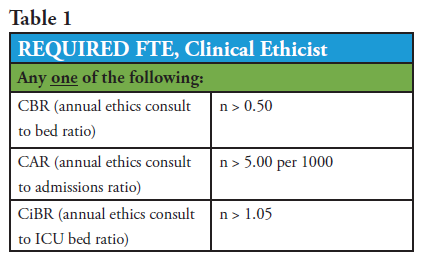
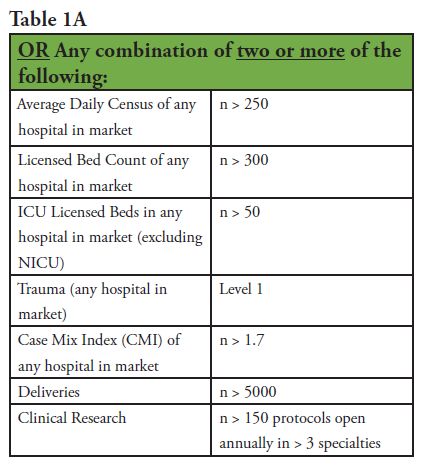
Table 1A also accounts for a combination of criteria that serve as a proxy where clinical ethics consultation volume alone may not warrant a required FTE in clinical ethics. In other words, despite the fact that a facility may be 200+ beds or maintain a 50+ bed ICU, for whatever reason it may not experience a significant volume of clinical ethics consultation.5 In the absence of this volume, the first six criteria suggest that the size of the facility or number and acuity of patients cared for, in my experience, warrants a required FTE in clinical ethics. Gremmels has made a similar argument citing the incidence rates of preeclampsia, premature rupture of membranes, and other causes of induction which often result in complex clinical ethics consultation6 thus establishing a threshold for number of deliveries. He also uses Trauma Levels7 and Case Mix Index8, but does so across differing recommendation levels and thus does not allow for comparison between categories based on similar criteria.
The last criteria represent an attempt to expand beyond metrics related directly to clinical care. Again, based largely on professional experience, human subjects research programs that have more than 150 open protocols tend to include some Phase I and Phase II studies which may reflect the integration of both safety and efficacy studies, respectively, into clinical service lines. These phases of human subject research may present significant issues related to informed consent,9 vulnerability of human subjects,10 and therapeutic misconception11 which, in tandem with another criterion related to clinical care, warrants a FTE in clinical ethics.Tables 2 and 2A illustrate consistency in the use of the criteria from Tables 1 and 1A while adjusting the metrics to account for the shift from "Required FTE" to "Strongly Recommend FTE." To account for the shift, Table 2 decreases the range in volume for all three metrics while Table 2A accounts for shifts in patient acuity and the magnitude of human subject research.
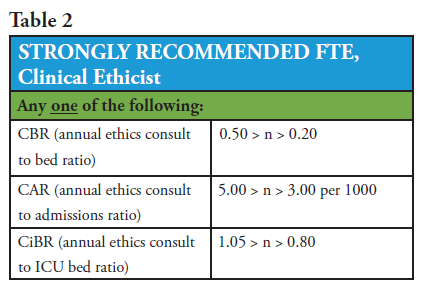
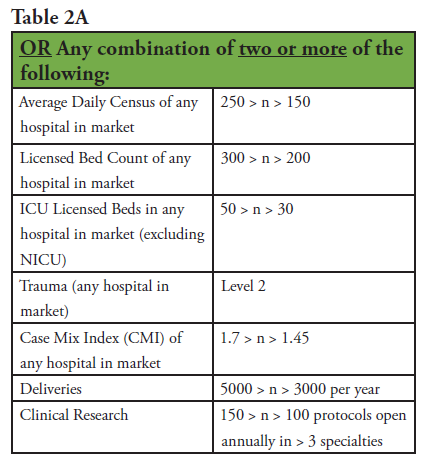
Finally, Table 3 adjusts to account for a shift from "Strongly Recommended" to "Recommended" by further decreasing volume metrics associated with clinical ethics consultation, while Table 3A does so by both removing criteria found in Tables 1A and 2A and decreasing the size of the facility or number and acuity of patients cared for.
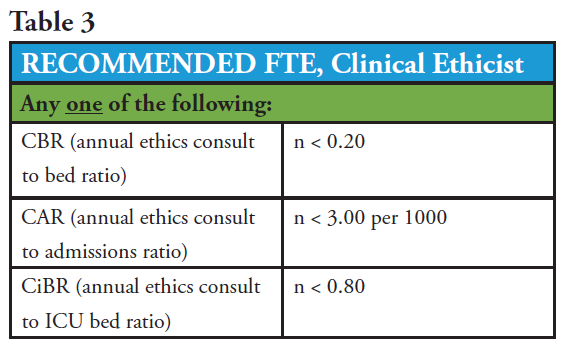
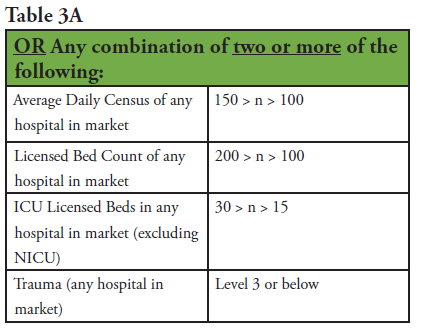
Although the criteria and structure may differ from that proposed by Gremmels in 2020, the similarities are important to note in that it may represent some emerging consensus in the field. I am not suggesting that two opinions constitute consensus in the field, especially given our prior collaboration on the topic. However, given the years of experience and number of clinical consultations that both Gremmels and I have participated in over the past 20 years, these models can certainly serve as a starting point for consideration of an FTE in clinical ethics for healthcare facilities and/or systems that heretofore have had few resources to which to turn.
Mark Repenshek, Ph.D.
Vice President, Ethics and Church Relations
Ascension
[email protected]
ENDNOTES
- Gremmels, B. "When to Hire a Clinical Ethicist." HCEUSA 28(1) (Winter-Spring 2020): 16-18.
- A.C. Glover, T.V. Cunningham, E.W. Sterling and J. Leandrini, "How much volume should healthcare ethics consult services have?" The Journal of Clinical Ethics 31, no. 2 (Summer 2020): 158-72. Use of the CiBR ratio was developed by S.L. Feldman, S.H. Riaz, J.S. Crites, J.Jankowski, and Paul J. Ford, on behalf of Cleveland Clinical HCEC Service, "Answering the Call for Standardized Reporting of Clinical Ethics Consultation Data," The Journal of Clinical Ethics 31, no. 2 (Summer 2020): 173-7.
- American Society of Bioethics and the Humanities, see: https://asbh.org/uploads/ASBH_Code_of_Ethics.pdf, accessed on December 31, 2020.
- The Catholic Health Association see: https://www.chausa.org/ethics/overview accessed on December 31, 2020.
- Fox, E., S. Myers, and R. A. Pearlman. "Ethics Consultation in United States Hospitals: A National Survey." American Journal of Bioethics 7, no. 2 (Feb 2007): 13-25.
- Gremmels, B. "When to Hire a Clinical Ethicist." HCEUSA 28(1) (Winter-Spring 2020): 16-18.
- American Trauma Society, https://www.amtrauma.org/page/traumalevels accessed on January 5, 2021 and J. MacKenzie et al., "National Inventory of Hospital Trauma Centers" JAMA 289(12) (March 26, 2003): 1566-7. For more specific delineation of Trauma Levels relative to qualifying criteria, see: Committee on Trauma. American College of Surgeons. "Optimal Care of the Injured Patient 2014". (Chicago:Il, 2014): 17-18 accessed on January 5, 2021.
- Although Case Mix Index (CMI) is used by the Centers for Medicare and Medicaid Services to determine funding allocation for Medicare and Medicaid beneficiaries in hospitals and other care facilities, CMI does reflect the diversity, clinical complexity, and resource needs for a particular facility. As such, a higher CMI tends to indicate more complex and resource-intensive case load. See: C Mendez, D Harrington, P Christensen and B Spellberg, "Impact of Hospital Variables on Case Mix Index as a Marker of Disease Severity." Population Health Management 17(1) (2014): 28-34.
- C Grady, "Enduring and Emerging Challenges of Informed Consent," NEJM 372 (February 26, 2015): 855-862.
- M Biros, "Capacity, Vulnerability, and Informed Consent for Research," The Journal of Law, Medicine & Ethics 46(1) (March 27, 2018): 72-78.
- P Appelbaum, "Therapeutic Misconception in Clinical Research: Frequency and Risk Factors." IRB Ethics and Human Research 26(2) (2004): 1-8.